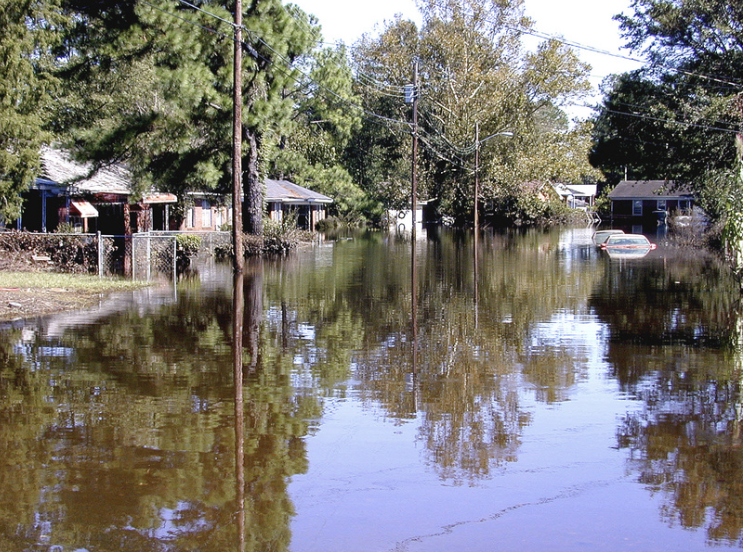What is Climate Finance?

How The Greenlining Institute is pushing corporate accountability & community investment in resilience
A long way from The Greenlining Institute’s headquarters in Oakland, California sits my hometown of Kinston, North Carolina. While we may be known for producing the most NBA basketball players of any town per capita, we are also, unfortunately, a poster child for the climate crisis and the persistent legacy of segregation. Kinston, no stranger to hurricane-induced flooding, has experienced two 1,000-year floods within the last five years, with predominantly Black neighborhoods situated in low-lying, flood-prone land bearing the brunt of these catastrophes. Back in 1999 after Hurricane Floyd, then considered to be one of the worst floods in our town’s history, FEMA came to town. In partnership with state and local government, nearly 800 homes located in the floodplain were bought and leveled in hopes of mitigating risk to human life and property from repeated flooding. Many of these homes were in historic Lincoln City, a sub-community of Kinston founded in the early 1900s by Black residents who bought homes near the river–one of their few options during times of segregation. This once thriving and economically prosperous section of Kinston is now reduced to only one resident still living in the area, and abandoned streets lined with overgrown trees.
Even though I was born and raised in Kinston, I did not know the history of Lincoln City and did not understand how all of these crises compounded one another. Jim Crow era-segregation and the vestiges of white supremacy, combined with worsening flood events and the continued disinvestment in Black communities, makes places like Lincoln City even more vulnerable to these very climate disasters. As I have recently returned to North Carolina after almost a decade in California and as a member of the broader climate policy advocacy community, I am constantly grappling with how we ensure the impacts of climate change occurring in our own backyards and in communities of color do not perpetuate the same injustices of the past.

If homeowners in Lincoln City had an option other than to take a FEMA buyout of their property and move away, would those neighbors still be there? What infrastructure improvements could have allowed residents to be able to weather flood events while keeping their community intact? Could there have been an opportunity to consider retreat from the river in a more socially cohesive way? Were FEMA buyouts really the best option? Who else could have played a role here?
One possible answer? Financial institutions and a burgeoning new field: climate finance.
Why Climate Finance?
Climate finance refers to “local, national, or transnational financing – drawn from public, private, and alternative sources of financing – that seeks to support mitigation and adaptation actions that will address climate change.” We are talking about the investments we need to make in order to reduce our emissions today, while preparing for changes in our climate coming tomorrow.
The public sector – meaning government institutions at the local, state, and federal levels – has an essential role to play in incentivizing climate action and meeting the subsequent financing needs. Public capital is often one of the most important pieces of the financing pie for any climate-related project. However, the private sector – meaning individuals, organizations, and companies outside of the government – and the finance sector in particular, has unmatched resources at its disposal to meet the capital needs of both industry and communities looking to plan for a difficult future. The most recent report from the International Panel on Climate Change (IPCC) highlights that while financing of climate projects has trended upwards, financing for adaptation related projects are insufficient to meet upcoming needs. Presently, the majority of financing comes from the public sector. According to the IPCC report, “enhanced mobilization of and access to financial resources are essential for implementation of adaptation.”
IN SHORT – WE NEED BANKS, ASSET MANAGERS, AND OTHER FINANCIAL INSTITUTIONS TO STEP UP AND START INVESTING IN COMMUNITY RESILIENCE IN A BIG WAY.
Why Greenlining?
For almost three decades, The Greenlining Institute has worked with financial institutions and their respective regulators to promote robust access to capital and investments in low-income communities and communities of color in order to foster a sustainable, more equitable future. We also have a long track record of directing climate-related investments to these same communities to support climate mitigation and adaptation activities. Greenlining has learned important lessons and gathered a strong understanding of how large institutions can effectively allocate capital to low-income communities and communities of color that furthers self-determination and boosts resilience while prioritizing racial equity. We know that economic equity and environmental justice are inextricably linked and we have an opportunity through climate finance to comprehensively address these challenges together. Otherwise, we risk exacerbating the current racial economic divide by failing to meet the financial needs of communities most susceptible to the impacts of climate change and climate disasters.
We are in good company in our mission. In this work, we join with several other partners in the climate financial regulatory space – including Americans for Financial Reform, Public Citizen, Center for American Progress, Sunrise Project, RMI, and Action Center on Race and the Economy, to name a few – to fight for strong, equitable action on climate from the finance sector.


The Work Ahead
In May 2021, President Biden issued an Executive Order on Climate-Related Financial Risk which outlined key strategies to ensure the public and private sectors are appropriately accounting for climate change in their activities and long-term planning. This includes priorities related to encouraging financial regulators to include climate-related financial risk in their assessments. Since then, we have seen landmark proposals from the Securities and Exchange Commission (SEC) to require publicly-traded companies to disclose information about their greenhouse gas emissions, as well as proposed guidance from both the Office of the Comptroller of the Currency (OCC) and the Federal Deposit Insurance Corporation (FDIC) on how financial institutions should manage climate-related financial risk. These various efforts demonstrate that financial regulators are beginning to take climate change and their respective responsibilities to manage risk more seriously.
In addition to these federal priorities, California continues to demonstrate leadership in addressing issues of climate change. We support the following California bills on climate finance issues:
- SB 1173 (Gonzalez and Wiener): Would prohibit CalPERS and CalSTERS from making new investments or renewing existing investments of retirement funds in fossil fuel companies.
- SB-260 (Wiener and Stern): The Climate Corporate Accountability Act would require companies with more than $1 billion in revenue that do business in California to disclose their greenhouse gas emissions.
- AB-1694 (Levine): Would require insurance companies to disclose investments in fossil fuel-related entities and companies.
Most of these efforts deal with upstream issues of climate finance, notably how to curtail the financing of climate change-inducing activities and risk mitigation.
AT GREENLINING, WE ARE ESPECIALLY CONCERNED WITH HOW INVESTMENTS WILL REACH LOW-INCOME COMMUNITIES AND COMMUNITIES OF COLOR.
One way we are tackling this is through our ongoing work in negotiating Community Benefits Agreements (CBAs) as part of bank mergers and acquisitions, in coalition with our partners at the California Reinvestment Coalition. For recently proposed mergers of US Bank and Union Bank as well as Bank of the West and BMO Harris, we have made recommendations related to disclosure and decarbonization, and emphasized that these new institutions should make robust commitments to invest in community resilience. Specifically, our asks include:
- Commit that the institution will not use “financial risk due to climate change” as a reason to cut investments in frontline communities. This means institutions should not use climate change as an excuse to refuse to invest in low-income communities of color.
- Commit significant resources to community-driven resilience projects. This means institutions should invest in projects like green affordable housing, electric vehicle (EV) charging infrastructure, community solar, resilience centers, and workforce development.
- Resources should also include philanthropic support of environmental justice organizations.
Also coming up this summer, we will be supporting efforts to strengthen the Community Reinvestment Act (CRA). For the first time in over 20 years, financial regulators will revisit guidelines for how financial institutions direct investments to low-income communities and communities of color, and we will be advocating for proactive investment of capital in environmental justice communities in concrete strategies to bolster resilience.
Support Our Work
Former residents of Lincoln City still gather for regular reunions to keep their community connection and legacy alive. And while it is true that the FEMA buyouts likely saved lives and reduced the economic burden on these residents, it comes at a loss of the social fabric of this community and to Kinston overall. The case of Lincoln City makes clear that we need a diversity of financial tools and strategies for dealing with these existential questions that climate change poses. Climate finance and financial institutions have an important role to play, and we at Greenlining look forward to working collaboratively with the industry, coalition partners, and regulators to better define these tools and strategies and support their broad implementation across the country.


